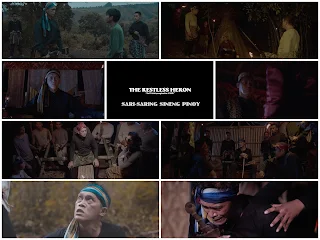The opening moments of Memories of the Rising Sun (Pelikulaw, P.D. Class 2014) shows filmmaker Lawrence Fajardo at his most confrontational, setting up the idea of what his central character, as well as his audience are in for. It seeks to detail the increasingly desperate conditions endured during the final days of World War II by the remaining Japanese forces who had so brutally conducted a three-year-plus occupation of the Philippines. An idiosyncratic artist whose bravest films often displayed a thoroughly odd obsession with fusing the brightest and bleakest aspects of human nature, Fajardo has always had a gift for crystallizing contradictions. His undeniable status as an auteur depends on a paradoxical dynamic: the ability to concretize the emotional quintessence of his material and visualize it on-screen has proved to be his most defining trait. He consistently attempts to visually render something metaphysical that is invisible, like the heart or the soul. The incendiary and extraordinary Memories of the Rising Sun is one of the few films to have the courage to wallow so directly in the offal of man’s inhumanity to man. It’s oneiric vision of wartime atrocities serve to emphasize a single abiding point: the innately human will for survival can sometimes seem a fate far worse than the certainty of death.
This level of suppression is indicative of a single, historically specific strain of mind, one that, in overlooking the sufferings of the subjugated Filipinos and focusing only on the desperations of the at-long-last defeated Japanese, felt at pains to deny the possibility to show the limits within which a moral existence is possible. Fajardo's choice to shoot in black-and-white is to bring out the story’s darker dimensions; the lack of vivid colors enables the headlong plunge into darkest corners of the human soul. In Memories of the Rising Sun Fajardo keeps on landing a visceral force to the narrative, using the nightmarish atmosphere to blur the lines of reality. Great performances from the cast enhance the madness that unfolds. Yoshihiko Hara is terrific as Captain Takahashi who desperately clings to his humanity despite the horrific circumstances. Garry Lim brings a level of ambiguity to the role of Lt. Nagata making the character seem untrustworthy. Ruby Ruiz showcases Helena’s slow drift to pandemonium. Her vacant, hollowed-out expression would sear its way into our mind to forever represent the grisly image of war.
Directed By: Lawrence Fajardo
Screenplay: John Bedia, Lawrence Fajardo
Director of Photography: Lawrence Fajardo, Manuel Abanto
Production Design: P.D. Class 2014
Edited By: Lawrence Fajardo
Musical Score: Peter Joseph Legaste
Sound Design: Cedric Regino










